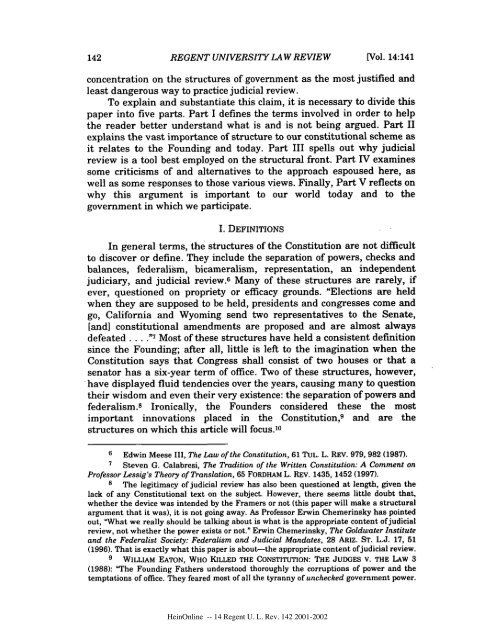Judicial ReEngineering
Judicial ReEngineering
Judicial ReEngineering
You also want an ePaper? Increase the reach of your titles
YUMPU automatically turns print PDFs into web optimized ePapers that Google loves.
REGENT UNIVERSITY LAW REVIEW<br />
[Vol. 14:141<br />
concentration on the structures of government as the most justified and<br />
least dangerous way to practice judicial review.<br />
To explain and substantiate this claim, it is necessary to divide this<br />
paper into five parts. Part I defines the terms involved in order to help<br />
the reader better understand what is and is not being argued. Part II<br />
explains the vast importance of structure to our constitutional scheme as<br />
it relates to the Founding and today. Part III spells out why judicial<br />
review is a tool best employed on the structural front. Part IV examines<br />
some criticisms of and alternatives to the approach espoused here, as<br />
well as some responses to those various views. Finally, Part V reflects on<br />
why this argument is important to our world today and to the<br />
government in which we participate.<br />
I. DEFINITIONS<br />
In general terms, the structures of the Constitution are not difficult<br />
to discover or define. They include the separation of powers, checks and<br />
balances, federalism, bicameralism, representation, an independent<br />
judiciary, and judicial review. 6 Many of these structures are rarely, if<br />
ever, questioned on propriety or efficacy grounds. "Elections are held<br />
when they are supposed to be held, presidents and congresses come and<br />
go, California and Wyoming send two representatives to the Senate,<br />
[and] constitutional amendments are proposed and are almost always<br />
defeated . . . ."7 Most of these structures have held a consistent definition<br />
since the Founding; after all, little is left to the imagination when the<br />
Constitution says that Congress shall consist of two houses or that a<br />
senator has a six-year term of office. Two of these structures, however,<br />
have displayed fluid tendencies over the years, causing many to question<br />
their wisdom and even their very existence: the separation of powers and<br />
federalism. 8 Ironically, the Founders considered these the most<br />
important innovations placed in the Constitution, 9 and are the<br />
structures on which this article will focus.1 0<br />
6 Edwin Meese III, The Law of the Constitution, 61 TUL. L. REV. 979, 982 (1987).<br />
7 Steven G. Calabresi, The Tradition of the Written Constitution: A Comment on<br />
Professor Lessig's Theory of Translation, 65 FORDHAM L. REV. 1435, 1452 (1997).<br />
8 The legitimacy of judicial review has also been questioned at length, given the<br />
lack of any Constitutional text on the subject. However, there seems little doubt that,<br />
whether the device was intended by the Framers or not (this paper will make a structural<br />
argument that it was), it is not going away. As Professor Erwin Chemerinsky has pointed<br />
out, "What we really should be talking about is what is the appropriate content of judicial<br />
review, not whether the power exists or not." Erwin Chemerinsky, The Goldwater Institute<br />
and the Federalist Society: Federalism and <strong>Judicial</strong> Mandates, 28 ARIz. ST. L.J. 17, 51<br />
(1996). That is exactly what this paper is about-the appropriate content of judicial review.<br />
9 WILLIAM EATON, WHO KILLED THE CONSTITUTION: THE JUDGES V. THE LAW 3<br />
(1988): "The Founding Fathers understood thoroughly the corruptions of power and the<br />
temptations of office. They feared most of all the tyranny of unchecked government power.<br />
HeinOnline -- 14 Regent U. L. Rev. 142 2001-2002

















